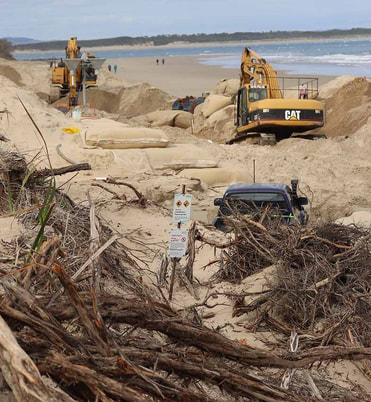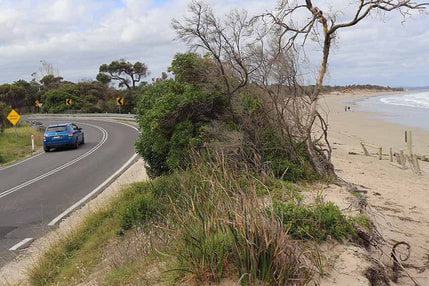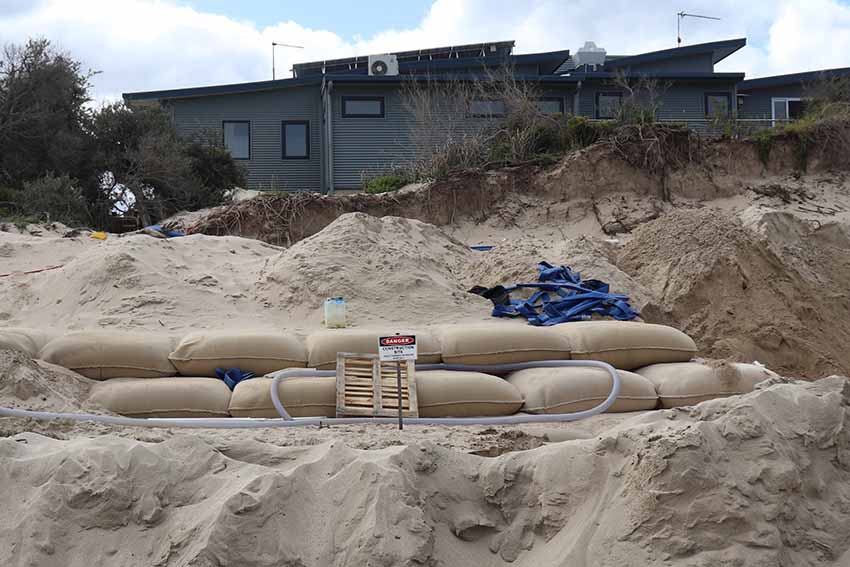 The clock is ticking as workers race to complete protection work on Inverloch beach before the storm season.
The clock is ticking as workers race to complete protection work on Inverloch beach before the storm season.
IN OUR brave new world the sign says this beach is closed. People rightly meander past and on the beach a scattered few keep their distance as they navigate around boulders and freshly cut caterpillar tracks.
Red bunting regulates a worksite. Within that insecure boundary, heaps of sacrificial sand keep the tide at bay as giant diggers fill giant sand bags to build a wall. Behind that wall are the narrow remains of a dune that once stretched 30 metres to the water’s distant edge.
The Inverloch Surf Life Saving Club cowers behind those bags. It makes sense to have such clubs near the water but this one is now far too close. As that protective dune diminished the general public, along with some experts, said that only rock, and lots of it, could save the clubhouse.
The multi-agency group that is responsible for the foreshore considered all the options. A geotextile wall was their preference.
The three person crew is being hampered by on-lookers getting too close to the digging machines. Workplace distancing is another impediment and around nine bags are now going into place on a good day.
If everything goes according to plan with those end assemblies and no further delays, Inverloch’s great wall of bags should be complete by April 17.
A short stroll away from all that activity a dishevelled sand fence is being smashed by the waves. Those waves are now close to an edge of bitumen. This is where Toorak Road passes Surf Parade and morphs into the Bunurong Coastal Drive. It would be very hard to replace.

However, drivers are getting nervous and the locals might be running a book on when Regional Roads Victoria finally relents and puts a solid barrier between the incoming tide and that irreplaceable road. The lack of activity here is in marked contrast to the effort to save the SLSC.
Another thing that puzzles the general public is the differing responses to erosion and inundation along our coastline.
In Jam Jerrup, Western Port edges closer to the power lines. The beach access steps have been washed away. The road is apparently doomed. A DELWP rock wall protects half the hamlet and there are unfunded plans for an extension that will hold back the tides. The only tangible response has been physical closure of the beach.
In Kilcunda the beach access steps behind the Lionel Rose car park have been swept away. Plastic barrier tape flutters in the breeze to commemorate the loss as warning signs protect citizens from the bleeding obvious threat of a lethal descent from that unstable cliff edge.
Over at Cowes East council has been performing sand renourishment but this doesn’t last. Further up that beach groyne replacement work has achieved good results, but more work is needed. The East Cowes Foreshore Group meets with council on a regular basis as federal Monash MP Russell Broadbent’s office struggles to bring forward the funding that was promised before last year’s election to expedite the work.
Locally, there is great concern about the state of the beach as we enter storm season and locals say the State Government needs to step up.
Across the shire, Grantville, The Gurdies and Lang Lang are just some of the other places where erosion is becoming an imminent threat.
We are Bass Coast. We are defined by our foreshores and constrained by our finances. People can debate whether inundation and erosion are simply part of a natural cycle or the result of climate change. But King Canute is not an acceptable role model. All levels of government need to act before is too late. Township retreats and loss of infrastructure can be avoided by action. Now.
Geoff Ellis is a councillor for Westernport Ward.
